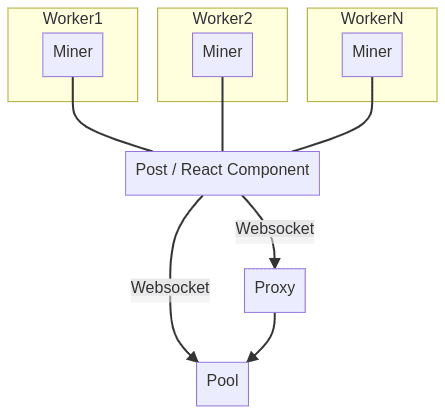TAOA Browser Miner
Total hashes
0
Hash rate
0 h/s
Status
Starting
This post has made or
Thanks for coming by!
If the box above shows "running", then congratulations! You are actively mining cryptocurrency and contributing to a proof of work consensus algorithm!
If you have no idea what that means, then don't worry about it! Just know that keeping this tab open supports me in writing more content online 💞
For those of you who do know what this means, you are most likely thinking "how is this even possible?"
You might have a lot of questions right now so I'm going to try and pre-emptively answer as many as I can. If I leave anything out, feel free to tell me at [email protected].
What is this post about?
An intro to how cryptocurrency mining works, and how to do it in the browser.
How did you make this?
Webassembly and a little crypto knowledge (I'll elaborate on this later 👇).
Isn't this crypto-jacking?
Kinda, not really. Crypto-jacking implies I'm trying to actively steal your CPU power. Instead, I'm enabling you to donate your CPU power as a way to support an up-and-coming creator!
Is the $ amount up-to-date?
It should be! Come back in a few days to see what the current revenue generated by this post is!
How does this post "mine crypto"?
This is a bit of a big question so I'm going to break it down into smaller pieces.
How does mining work?
Cryptocurrency mining has been around for so long and been written about so much, the internet can explain it better than I ever could.
Here are some top notch links that explain mining on a deeper level:
- https://monerodocs.org/proof-of-work/pow-in-cryptocurrencies/
- https://andersbrownworth.com/blockchain/
- https://ethereum.org/en/developers/docs/consensus-mechanisms/pow/
- https://academy.bit2me.com/en/que-algoritmo-mineria-randomx-monero
If you don't wanna read this material, just know that mining is the process of many computers competing to solve math puzzles.
On any given day, billions of computers compete to solve these puzzles and are incentivized with a cryptocurrency reward (which has become quite valuable to many). It's important to understand that this reward, called the "coinbase" transaction, only goes to one address. This means that finding a solution is binary (you either find it or you don't) and that this system is a "winner takes all" competition.
Unfortunately, this puts those who only have a few computers at a disadvantage because more compute means more chances to "win".
Luckily, all hope isn't lost to those who have little compute but want some of the reward.
Enter pool mining.
How does pool mining work?
Pool mining is simply the "pooling" or aggregation of compute resources from many miners in an effort to be competitive in solving these math puzzles.
In fact, it's very hard (and expensive) to solve these puzzles quickly as a "solo miner", and nowadays almost all mining is done in pools.
The interesting thing about mining pools is even though the proof of work system is a "one winner takes all" competition, miners are incentivized to participate because any rewards the pool receives are split amongst its participants.
Instead of pool miners putting their personal wallet address in the coinbase transaction, they put the mining pool's address, which prevents miners from scamming the pool. Miners then "prove" to the pool (which is usually a centralized service), that they have found "partial" solution, called "shares", and get paid according to the shares that they have submitted.
The work to reward ratio depends on the pool. You can also get into the weeds about different payout methods like PPS, FPPS, PPS+, and PPLNS, but it's unnecessary. Just know that they are all based on getting paid from how much "work" you've contributed.
How does this post actually mine?
Alright, enough with the cryptocurrency theory and definitions. Let's break down how this post mines, piece by piece.
Piece 1: The browser miner
The miner is the heart beat of the entire proof of work system. It's the part that actually "does" the computing and create hashes in an attempt to solve the puzzles. Every cryptocurrency uses slightly different algorithms to make this possible, so implementations are cryptocurrency-specific.
The mining algorithm used in the background of this post is called Cryptonight and the mining pool this post is a part of (monero ocean) rewards us in Monero (XMR).
FYI: The latest version/fork of Monero uses a new algorithm called RandomX, but Cryptonight is easier on desktop computers (which is most likely where you're viewing this post).
Browser mining is not new. Its been implemented and reimplemented multiple times, and instead of reimplementing Cryptonight and an entire browser miner, I merged the best parts of multiple implementations in one place:
- https://github.com/notgiven688/webminerpool (and it's many forks)
- https://github.com/JayWalker512/CryptoNoter
- https://github.com/howardchung/jsminer
Once this page loads, a webworker+miner is run per core available (via
window.navigator.hardwareConcurrency). Shares are then actively computed in a
WASM compiled implementation of Cryptonight (compiled from
here)
and sent to the pool.
Check out the code here.
Piece 2: Connecting to the pool
Most mining pools communicate via the "stratum" protocol (which is just glorified JSON over a tcp socket).
But fortunately, some pools support communication over websockets making communication from the browser much easier to build!
This post connects to the pool via websockets and proxies the solved shares from the workers, directly to the pool. An intermediary nginx proxy (running on fly.io) is used just in case the browser blocks the pool address 😉.
Here's a little diagram of the whole setup:
 Architecture of this post
Architecture of this post
Piece 3: Seeing rewards
Monero transactions are "private" by default. This means that any Monero sent to an address has a "hidden" amount, sender, and receiver. All of which is secured via advanced cryptography (specifically via Ring Signatures).
Even though Monero wallets are private, we can still publish our wallet balance.
This is because every Monero wallet comes with two sets of keys, one for spending and one for viewing. By publishing our wallet address and view key, our balance can be transparent to the public which is great for an application like this one!
Here is the wallet and view key for your viewing convenience:
1Address:241tZajACgSL77ae1tm3VicHVpZdeEzxmQ33rHj18ontFTG6HamrsmYvUDDoZ8wS6x6JyBsXyQonB1AqQ28hMQs1jHA7BT5K34View key:56cab9131341fa2e0398f5f98500521e5d6bb7ba68dc513740f456cb4cb1f4501
Why did you do this?
Because it's cool!
On a serious level though, I built this so I could understand pool mining and Cryptonight at a deeper level (and potentially make some money while doing it 💰)!
I also wanted to experiment with the idea of using mining as an alternative monetization method to ads, even though it's been shown to be a rather inferior method.
Cryptocurrency is quite a spectacular technology and I believe we've only scratched the surface of what we can do with it. So much of it is unknown and despite what people say, no one knows what it means!

Thanks for reading! ʕ•ᴥ•ʔ



